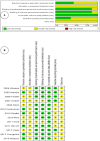Probiotics for the Treatment of Atopic Dermatitis in Children: A Systematic Review and Meta-Analysis of Randomized Controlled Trials
- PMID: 28932705
- PMCID: PMC5592329
- DOI: 10.3389/fcimb.2017.00392
Probiotics for the Treatment of Atopic Dermatitis in Children: A Systematic Review and Meta-Analysis of Randomized Controlled Trials
Abstract
Objective: Atopic dermatitis (AD) is a prevalent, burdensome, and psychologically important pediatric concern. Probiotics have been suggested as a treatment for AD. Some reports have explored this topic; however, the utility of probiotics for AD remains to be firmly established. Methods: To assess the effects of probiotics on AD in children, the PubMed/Medline, Cochrane Library Scopus, and OVID databases were searched for reports published in the English language. Results: Thirteen studies were identified. Significantly higher SCORAD values favoring probiotics over controls were observed (mean difference [MD], -3.07; 95% confidence interval [CI], -6.12 to -0.03; P < 0.001). The reported efficacy of probiotics in children < 1 year old was -1.03 (95%CI, -7.05 to 4.99) and that in children 1-18 years old was -4.50 (95%CI, -7.45 to -1.54; P < 0.001). Subgroup analyses showed that in Europe, SCORAD revealed no effect of probiotics, whereas significantly lower SCORAD values were reported in Asia (MD, -5.39; 95%CI, -8.91 to -1.87). Lactobacillus rhamnosus GG (MD, 3.29; 95%CI, -0.30 to 6.88; P = 0.07) and Lactobacillus plantarum (MD, -0.70; 95%CI, -2.30 to 0.90; P = 0.39) showed no significant effect on SCORAD values in children with AD. However, Lactobacillus fermentum (MD, -11.42; 95%CI, -13.81 to -9.04), Lactobacillus salivarius (MD, -7.21; 95%CI, -9.63 to -4.78), and a mixture of different strains (MD, -3.52; 95%CI, -5.61 to -1.44) showed significant effects on SCORAD values in children with AD. Conclusions: Our meta-analysis indicated that the research to date has not robustly shown that probiotics are beneficial for children with AD. However, caution is needed when generalizing our results, as the populations evaluated were heterogeneous. Randomized controlled trials with larger samples and greater power are necessary to identify the species, dose, and treatment duration of probiotics that are most efficacious for treating AD in children.
Keywords: children; constipation; meta-analysis; probiotics; randomized controlled trial.
Figures







References
-
- Alexander P. E., Bonner A. J., Agarwal A., Li S. A., Hariharan A. T., Izhar Z., et al. . (2016). Sensitivity subgroup analysis based on single-center vs. multi-center trial status when interpreting meta-analyses pooled estimates: the logical way forward. J. Clin. Epidemiol. 74, 80–92. 10.1016/j.jclinepi.2015.08.027 - DOI - PubMed
-
- Chang H. Y., Chen J. H., Chang J. H., Lin H. C., Lin C. Y., Peng C. C. (2017). Multiple strains probiotics appear to be the most effective probiotics in the prevention of necrotizing enterocolitis and mortality: an updated meta-analysis. PLoS ONE 12:e171579. 10.1371/journal.pone.0171579 - DOI - PMC - PubMed
Publication types
MeSH terms
LinkOut - more resources
Full Text Sources
Other Literature Sources
Medical

